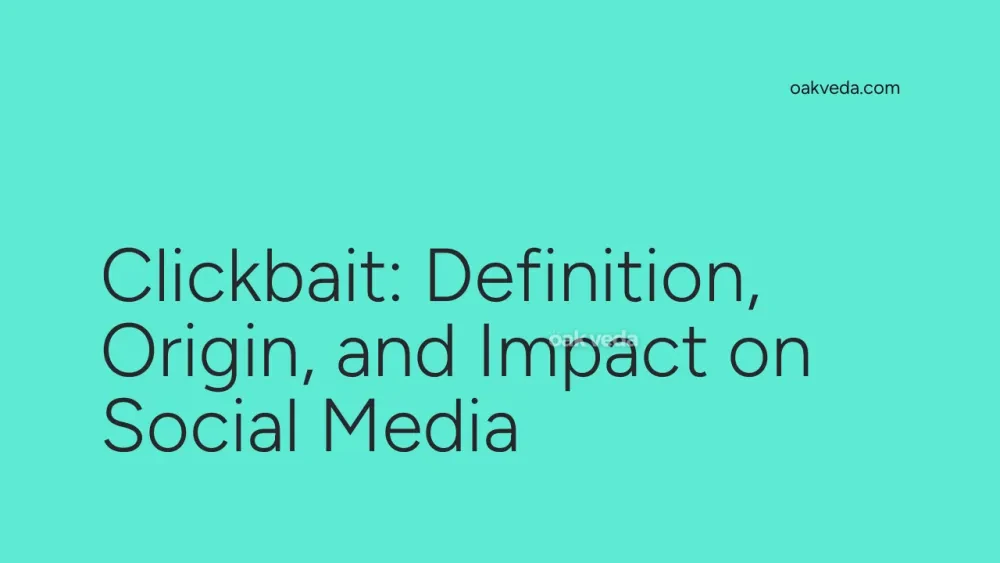
What is Clickbait?
Clickbait is a content strategy used in digital marketing and social media to attract user attention and encourage clicks on links, articles, or videos. It typically involves creating sensational, misleading, or exaggerated headlines, thumbnails, or descriptions that pique curiosity but often fail to deliver on their promises. The primary goal of clickbait is to generate traffic, increase page views, and potentially boost ad revenue or other forms of monetization.
Origin and Development of Clickbait
While the term "clickbait" gained popularity in the digital age, the concept has roots in traditional media. Tabloid newspapers and sensationalist journalism have long used eye-catching headlines to sell more copies. However, the rise of social media and online advertising in the early 2000s created a perfect environment for clickbait to flourish.
As social platforms like Facebook, Twitter, and YouTube grew, so did the competition for user attention. Content creators and publishers began experimenting with increasingly provocative headlines to stand out in crowded news feeds. The term "clickbait" itself entered common usage around 2010, reflecting the growing awareness of this tactic.
How Clickbait Works
Clickbait capitalizes on human psychology, particularly our curiosity and desire for novel information. It often employs techniques such as:
- Creating information gaps: Teasing readers with partial information, prompting them to click for the full story.
- Emotional triggers: Using words that evoke strong emotions like surprise, anger, or excitement.
- Listicles: Presenting content in numbered lists, promising quick, digestible information.
- Shocking claims: Making outrageous statements that seem too incredible to ignore.
- Celebrity references: Leveraging famous names to attract attention, even if the connection is tenuous.
Types of Clickbait
Clickbait comes in various forms, including:
- Headline clickbait: Sensational or misleading article titles.
- Thumbnail clickbait: Using manipulated or unrelated images to attract clicks on videos.
- Social media clickbait: Posts designed to encourage shares and engagement, often with emotional appeals.
- Quiz or personality test clickbait: Interactive content that promises insights into the user's personality or knowledge.
Popular Examples of Clickbait
Some common clickbait formulas include:
- "You won't believe what happened next..."
- "This one weird trick will change your life forever!"
- "10 shocking secrets [celebrities] don't want you to know!"
- "The truth about [topic] will leave you speechless!"
- "This [ordinary item] may be the key to solving [major problem]"
These headlines are designed to create a sense of urgency, exclusivity, or disbelief, compelling users to click through to satisfy their curiosity.
Impact of Clickbait on Social Media Culture
Clickbait has significantly influenced online content consumption and creation:
- Shortened attention spans: Users are conditioned to expect instant gratification, often skimming content rather than engaging deeply.
- Erosion of trust: Repeated exposure to misleading clickbait can make users more skeptical of online content in general.
- Content quality concerns: The pressure to create attention-grabbing headlines can sometimes overshadow the importance of substantive content.
- Algorithm changes: Social media platforms have had to adapt their algorithms to combat excessive clickbait, affecting content visibility.
Controversies Surrounding Clickbait
Clickbait is a contentious topic in the digital media landscape:
- Ethical concerns: Critics argue that clickbait is deceptive and undermines journalistic integrity.
- User frustration: Many people feel misled or disappointed when clickbait content fails to deliver on its promises.
- Misinformation spread: Sensational headlines can sometimes contribute to the spread of false or misleading information.
- Ad revenue debates: While clickbait can drive traffic, it may harm long-term audience trust and engagement.
How Brands and Influencers Use Clickbait
Despite the controversies, many brands and influencers continue to use clickbait-like tactics, albeit more subtly:
- Curiosity-driven content: Creating intriguing but less misleading headlines to encourage clicks.
- Emotional storytelling: Using compelling narratives to draw readers in without resorting to outright deception.
- Teaser content: Offering previews or snippets of content to entice users to engage further.
- Strategic use of visuals: Employing eye-catching images or video thumbnails that accurately represent the content.
Future Trends Related to Clickbait
As digital media evolves, so does the landscape of clickbait:
- AI-powered content moderation: Platforms are developing more sophisticated tools to detect and demote clickbait.
- User education: Increased media literacy efforts may help users become more discerning consumers of online content.
- Quality-focused algorithms: Social media platforms are likely to continue refining their algorithms to prioritize high-quality, engaging content over mere click-bait.
- Native advertising evolution: Brands may shift towards more authentic, value-driven content marketing strategies.
FAQs about Clickbait
-
Is all clickbait bad? Not necessarily. Some content creators use attention-grabbing headlines responsibly to draw users to genuinely valuable content.
-
How can I avoid falling for clickbait? Be skeptical of sensational headlines, check the source's credibility, and look for corroborating information before sharing.
-
Do social media platforms penalize clickbait? Many platforms have implemented measures to reduce the visibility of content deemed as clickbait, though the effectiveness varies.
-
Can clickbait be part of a legitimate marketing strategy? While pure clickbait is generally discouraged, elements of curiosity-driven content can be effectively used in ethical marketing strategies.
In conclusion, while clickbait remains a prevalent force in social media, its future lies in striking a balance between attention-grabbing tactics and delivering genuine value to users. As both platforms and consumers become more sophisticated, the most successful content strategies will likely focus on creating compelling, honest, and truly engaging experiences.
You may be interested in:
- Unwell: Definition, Origin, and Impact on Social Media
- GIF: Definition, Origin, and Impact on Social Media
- Influencer Marketing: Definition, Origin, and Impact
- Nepo Baby: Definition, Origin, and Impact on Social Media
- Clapback: Definition, Origin, and Impact on Social Media
- Old Money Aesthetic: Definition, Origin, and Impact

